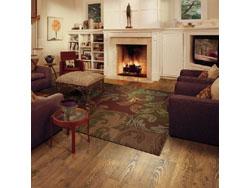Area Rugs Can Boost Your Sales - July 2007
By Sonya Jennings
According to Jim Curtin at Shaw Living, within 30 days of buying a hardwood or ceramic floor, the average consumer is going to buy an area rug. If she’s already standing in your store, why not sell her a rug right then?
There are so many good business reasons for retailers to add rugs to their product mix. The profit margin on rugs is high—40% to 60%—and there’s no measuring or installation cost associated with the sale. It’s a cash and carry business. Jonathan Witt at Oriental Weavers points out, “Since 1998, hard surfaces and rug sales have almost doubled. When someone buys a hard surface floor, they’re usually going to put a rug on it.”
Yet surprisingly, more than 95% of rugs sales are made in department stores, furniture stores, rug specialty shops, mass merchants and big boxes. Less than 5% are sold in flooring stores.
We spoke with several flooring retailers around the country who have boosted their overall sales by offering area rugs. Brenda Barber of Barber Floors in St. Johns, Michigan says, “I want to get all of the sale, not just part of it. That is why we carry rugs.”
Displaying rugs takes your store to the next level in style. Paul Wisnoski of Carpet Interiors, Carpet One in Oak Lawn, Illinois says, “Rugs are large pieces of art. When they’re hanging in your store, it upgrades your whole image.”
It’s not necessary to have an interior designer on staff to help customers choose rugs, but it is helpful to have someone with an eye for matching pillows and/or fabric swatches to a rug. At the very least, a talented salesperson can listen to the customer and serve as a sounding board. Choosing a rug is a lot like shopping for art—you just know you like it when you see it. If your customer likes a particular rug and it matches her fabric swatches, it will probably work in the room.
If you’re thinking of expanding into rug sales, here are a few secrets to being successful.
1. Show lots of rugs.
Harrel Zivits of Floor de Lis in New Orleans, Louisiana says, “Jump in, don’t wade. If you’re going to carry rugs, you have to start with enough of a selection to offer the customer what she wants.” The larger rugs (8x11 and 10x13) are the best sellers. Paul Wisnoski of Carpet Interiors Carpet One believes “showing a minimum of 80 large rugs is a good starting point. We show 250 to 300 in each of our two stores.” Offering rugs in every style category (contemporary, traditional, casual, etc.) is key to appealing to every customer.
The upfront investment to purchase 80 large rugs is in the neighborhood of $40,000 (assuming approximately $500 a rug). Check with rug manufacturers for extended financing terms if this price is too steep to take on at one time. Brenda Barber of Barber Floors says, “When we began selling rugs, we bought only one 5x7 rack. It wasn’t until we added another one, plus an 8x12 rack, that our rug business took off. The more rugs we carry, the more we sell.”
2. Make the space.
All the retailers we spoke with agree that you must hang rugs to sell them. Stacks of rugs on the floor don’t sell because it’s just too much work to actually look at each one. Rugs displayed on hanging racks are easy to view, and the customer can see the whole rug—not just a corner. Brenda Barber says, “Eliminate something that’s not selling and create the space for a couple of racks. Hanging racks sell rugs.”
3. Appoint an employee to manage your rug business.
Someone in your store should be managing your rug business. This person needs to know what’s selling and what’s sitting. When a customer buys a rug, you need to know if it had to be marked down again and again or if it sold quickly. If it took markdowns to sell it, your rug manager must make the decision whether or not to order that rug again. On the other hand, if a rug sells quickly, it should be reordered immediately. Reordering popular styles is key to a booming rug business. Someone must manage this process.
Entering the rug business may be a little out of your comfort zone, but do your research and remember that your customer is most likely going to purchase a rug for her hard surface floor. It works out best for both of you if she can get the product from you rather than making another trip to spend her money somewhere else.
Copyright 2007 Floor Focus
Related Topics:Shaw Industries Group, Inc., Carpet One
